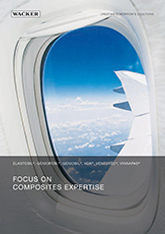Our system has noticed that you are based in United States, but the current country setting is India. Do you still want to change your country?
Composite Molding

Large number of reproductions: the bags (approx. 4x3 m) can be rolled up for transportation and used again and again. This bag has already beed used 250 times.
From aeronautic, through transportation to consumer goods, many application areas are now unimaginable without fiber-reinforced plastic composites. WACKER silicone rubbers and fabrics for re-usable vacuum bags improve the composite resin infusion molding process. These silicone bags are placed quickly and securely over the mold before each part is produced. Repeated, time-consuming sealing with conventional vacuum film is no longer necessary.

Benefits of Silicone Bag Technology:
- Faster production
- Better repeatability and quality
- Lower emissions of volatile components
- Less waste
- Less labor intensive
Benefits of ELASTOSIL®:
- Flexible
- Yet self-leveling
- Longer pot life and curing time
- Suitable for large surfaces
- Suitable for vertical surfaces
- Reusable
Silicones are also used for the production of wedges or bladders, used to apply pressure to the composite during the manufacturing process. Re-usability and release properties together with good chemical resistance are the key advantages here.
Produktempfehlungen
|
Produkte
|
Technische Daten
|
Produktmerkmale
|
|||||||||
|---|---|---|---|---|---|---|---|---|---|---|---|
| Viscosity, dynamic | Tear strength | Hardness Shore A | Tensile strength | Elongation at break | Beständigkeit | Oberflächeneigenschaft | Regulatorisch | Rheologie | Vernetzungseigenschaft | ||
| 8000 mPa·s[1] 8000 mPa·s[1] | > 20 N/mm[3] > 20 N/mm[3] | 26[4] 26[4] | 5 N/mm²[6] 5 N/mm²[6] | 500 %[8] 500 %[8] | Beständigkeit gegenüber Beton | - | Lebensmittelkontakt | Fließfähig | kein chemischer Schrumpf, zweikomponentig, Additionsvernetzend | ||
| 20000 mPa·s[1] 20000 mPa·s[1] | 25 N/mm[3] 25 N/mm[3] | 25[4] 25[4] | 5 N/mm²[6] 5 N/mm²[6] | 500 %[8] 500 %[8] | Beständigkeit gegenüber Polyester, Beständigkeit gegenüber Epoxidharzen | - | - | Fließfähig | kein chemischer Schrumpf, zweikomponentig, Additionsvernetzend, Schnelle Aushärtung bei Raumtemperatur | ||
| 15000 mPa·s[2] 15000 mPa·s[2] | > 30 N/mm[3] > 30 N/mm[3] | 28[5] 28[5] | 6.5 N/mm²[7] 6.5 N/mm²[7] | 700 %[9] 700 %[9] | Beständigkeit gegenüber Gießharzen | - | Lebensmittelkontakt | Fließfähig | kein chemischer Schrumpf, zweikomponentig, Additionsvernetzend | ||
| 20000 mPa·s[2] 20000 mPa·s[2] | > 30 N/mm[3] > 30 N/mm[3] | 37[5] 37[5] | 7 N/mm²[7] 7 N/mm²[7] | 480 %[9] 480 %[9] | Beständigkeit gegenüber Gießharzen | - | - | Fließfähig | kein chemischer Schrumpf, zweikomponentig, Additionsvernetzend | ||
| 120000 mPa·s[2] 120000 mPa·s[2] | 15 N/mm[3] 15 N/mm[3] | 55[4] 55[4] | 5.5 N/mm²[6] 5.5 N/mm²[6] | 280 %[8] 280 %[8] | Beständigkeit gegenüber Polyester, Beständigkeit gegenüber Epoxidharzen, Beständigkeit gegenüber PU | Trockene Oberfläche | Lebensmittelkontakt | Fließfähig | kein chemischer Schrumpf, zweikomponentig, Additionsvernetzend | ||
| 25000 mPa·s[2] 25000 mPa·s[2] | 30 N/mm[3] 30 N/mm[3] | 25[4] 25[4] | 6.5 N/mm²[6] 6.5 N/mm²[6] | 600 %[8] 600 %[8] | - | - | - | Fließfähig | zweikomponentig, Additionsvernetzend | ||
[1] Viscosity, dynamic | 23 °C | ISO 3219, [2] Viscosity, dynamic after stirring | 23 °C | ISO 3219, [3] Tear strength | ASTM D 624 B, [4] Hardness Shore A | DIN ISO 48-4, [5] Hardness Shore A | ISO 868, [6] Tensile strength | ISO 37 type 1, [7] Tensile strength | ISO 37, [8] Elongation at break | ISO 37 type 1, [9] Elongation at break | ISO 37





